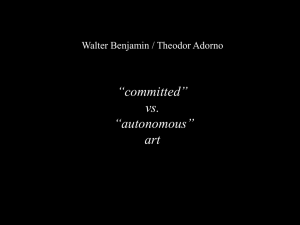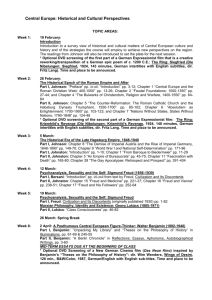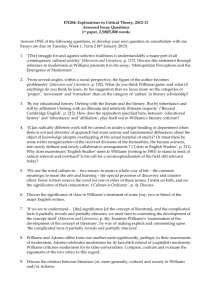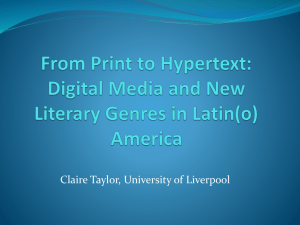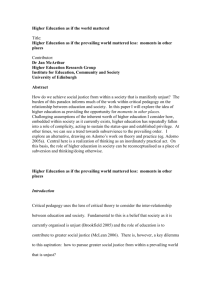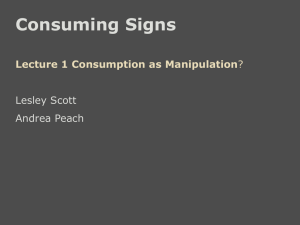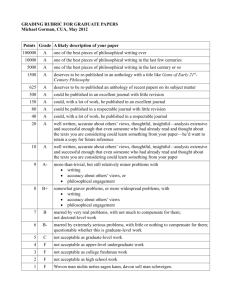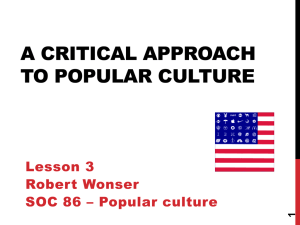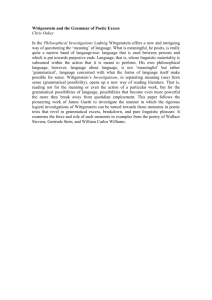MA Courses 2013 � - Stony Brook University
advertisement
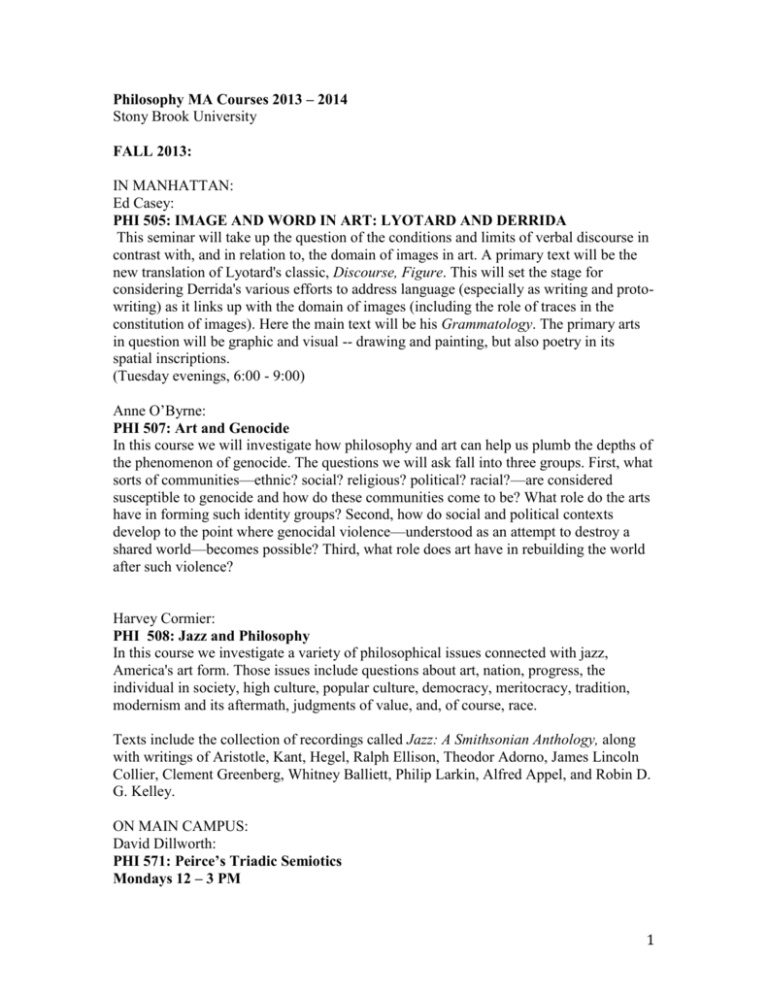
Philosophy MA Courses 2013 – 2014 Stony Brook University FALL 2013: IN MANHATTAN: Ed Casey: PHI 505: IMAGE AND WORD IN ART: LYOTARD AND DERRIDA This seminar will take up the question of the conditions and limits of verbal discourse in contrast with, and in relation to, the domain of images in art. A primary text will be the new translation of Lyotard's classic, Discourse, Figure. This will set the stage for considering Derrida's various efforts to address language (especially as writing and protowriting) as it links up with the domain of images (including the role of traces in the constitution of images). Here the main text will be his Grammatology. The primary arts in question will be graphic and visual -- drawing and painting, but also poetry in its spatial inscriptions. (Tuesday evenings, 6:00 - 9:00) Anne O’Byrne: PHI 507: Art and Genocide In this course we will investigate how philosophy and art can help us plumb the depths of the phenomenon of genocide. The questions we will ask fall into three groups. First, what sorts of communities—ethnic? social? religious? political? racial?—are considered susceptible to genocide and how do these communities come to be? What role do the arts have in forming such identity groups? Second, how do social and political contexts develop to the point where genocidal violence—understood as an attempt to destroy a shared world—becomes possible? Third, what role does art have in rebuilding the world after such violence? Harvey Cormier: PHI 508: Jazz and Philosophy In this course we investigate a variety of philosophical issues connected with jazz, America's art form. Those issues include questions about art, nation, progress, the individual in society, high culture, popular culture, democracy, meritocracy, tradition, modernism and its aftermath, judgments of value, and, of course, race. Texts include the collection of recordings called Jazz: A Smithsonian Anthology, along with writings of Aristotle, Kant, Hegel, Ralph Ellison, Theodor Adorno, James Lincoln Collier, Clement Greenberg, Whitney Balliett, Philip Larkin, Alfred Appel, and Robin D. G. Kelley. ON MAIN CAMPUS: David Dillworth: PHI 571: Peirce’s Triadic Semiotics Mondays 12 – 3 PM 1 Now arguably the centerpiece of the American philosophical tradition, Peirce’s semeiotics (theory of triadic sign-transference in an informational universe) circumscribes the range of forms of dyadic hermeneutics. In Peirce’s words, dyadic hermeneutics—stemming from Descartes, Locke, and Kant and exemplified in many interpretive programs of the contemporary academy—operates “by chopping with an axe.” In historico-pedagogical perspective, Peirce’s triadic theory drew from a transatlantic background in Goethe and Schiller in relation to Kant and realistic-idealistic elaborations in Schelling and Hegel; closer to home, Emerson, in the generation before Peirce, became a chief conduit of these ideas, and William James contributed his own indispensable descriptions toward a trivalent theory of experiential signification. Course segments: 1. Readings in Emerson’s Nature (1836), and such essays as “The Method of Nature,” “The Over-soul,” and “Circles” (1841); “The Poet” and “Nature” (1844); “Fate, “Beauty,” and “Illusions” (1860); and such poems as “The Sphinx,” “The World-Soul,” “Bacchus,” and “Wood-notes.” Emerson’s Transcendentalist writings portray the perceptual signs of nature as symbolically sacramental. They form the literary precedent to Peirce’s semeiotic doctrine of the mind’s instinctbased capacity for transparent sign-functions in the sciences and arts. 2. Overlapping Emerson’s career, the young Peirce published post-Cartesian and post-Kantian epistemological essays such as “Some Consequences of Four Incapacities” (1867), “The Fixation of Belief” and “How to Make Our Ideas Clear” (1868); he developed three phenomenological and metaphysical categories in “A Guess at the Riddle” (1887-88) and five Monist series papers (1891-94); he expanded his system by articulation of three normative categories (Esthetics, Ethics, Logic) in an overall classification of the sciences (1903). Later-phase writings included “A Neglected Argument for the Reality of God” and “An Essay toward Reasoning in Security and Uberty.” These essays further grounded his trivalent semeiotics (the first branch of Logic), which he framed in terms of icons, indices, and symbols and the latter in terms of emotional, dynamical, and logical interpretants, by which he advanced his thesis, indebted to Emerson, that “the universe is perfused with signs.” 3. In such later writings as Essays in Radical Empiricism and Some Problems of Philosophy James complemented Emerson and Peirce in essential ways. James had a genius for expressing the metamorphoses of experience as creative relations in continuous, including cosmically co-conscious, transitions. It is difficult to parse the precise differences between Peirce and James. In the main James’ psychological descriptions covered the same ground as Peirce’s mature system, complementing the latter’s more sharply cut phenomenological and semiotic categorizations. Readings drawn from: 2 Emerson, Essays and Lectures, The Library of America. Peirce, Essential Writings, Indiana U. Press, vol. 1 & 2. Wm. James, 1902-1910 Writings, The Library of America. Donn Welton: PHI 509: Phenomenology of Self and Persons: Body, Affectivity and the Generation of Values Mondays 4 – 7 PM After a brief survey of several foundational ideas in Husserl, Merleau-Ponty and Binswanger, two thirds of this seminar will focus on the newly published translation of The Ego and the Flesh by Jacob Rogozinski. The author himself will be at Stony Brook for two weeks in October; he will lead at least two of our sessions and we will join others that he might offer during his stay. The final third will shift from the theory of the self to theory of the person and use several seminal essays by Ricoeur to guide us in our thinking. 3 SPRING 2014 In Manhattan: Megan Craig: PHI 507: Late Wittgenstein: Color, Certainty, and Belief Tuesdays: 12 – 3 PM This course investigates the ethical and aesthetic dimensions of Wittgenstein’s late work. Our discussions will focus around Wittgenstein’s use of color and color examples throughout various texts, the relationship between phenomenology, psychology, and logic, the ethical implications of language acquisition and Wittgenstein’s concepts of “language games” and “family resemblances,” and the differences/similarities between certainty and belief. We may also touch on the religious aspects of some of Wittgenstein’s late remarks, as well as the relationship between his work and other philosophical/artistic theories of color, language, and perception. We will be doing close readings of parts of The Philosophical Investigations, all of Remarks on Colour, and sections of On Certainty and The Blue and Brown Books, in addition to relevant secondary literature. This is a writing intensive seminar. Required Texts: Wittgenstein, The Philosophical Investigations Remarks on Colour On Certainty The Blue and Brown Books Robert Crease: PHI 508: Dance and the Lived Body If painting, as Merleau-Ponty writes, is the art that shows us how things become things and world becomes world, dance may be said to be the art that shows us how bodies become bodies. It is the art that, as Merce Cunningham writes, gives you no objects, nor things to hang on the wall to look at, nor texts to read, but only “that single fleeting moment when you feel alive”. Dance explores and exposes the body in its temporality, finitude, and mortality. Its medium is the ecstatic body, always already beyond itself in the world and with the world in us. This course examines the origin and nature of dancing, and explores it as a medium in which to rethink embodiment. The course also examines why philosophers’ evasion of dancing as a topic is at once a scandal, mystery, and opportunity. Topics entwined with dancing include improvisation, play, rhythm, style, bipedality, and apprenticeship learning. Required texts include Maxine SheetsJohnstone, The Corporeal Turn. Eva Kittay: PHI 521: Disability and Ethics The norm of the agent in philosophical thought has been fully functioning and fully able. Disability is used largely as a metaphor to underscore some philosophical point in an argument. But in any given society there will be those with disabilities and the exclusion of their perspective and concerns are no longer viewed as viable. Furthermore, thinking 4 about disability has opened important questions about presumptions of the independent self-sufficient moral actor, conceptions of moral culpability, the idea of moral personhood, the adequacy of political theories to embrace disabled citizens, and to the very nature of the ties that bind us. The problems embraced range from metaphysical questions about personhood to questions of legal status and human rights. In this course we will explore the nascent but quickly growing literature on disability and its intersection with philosophical questions. We will also inclue material from literature, film and disability studies to enhance our philosophical exploration. Hugh Silverman (on Main Campus): PHI 505/ PHI 420: Derrida Reading Heidegger Cross-Listed Courses (on Main Campus): John Lutterbie: PHI 508/ THR 635: Theories of Performance: The European Avant-Garde The question of creativity is posed focusing on the European Avant-Garde (Symbolism to Surrealism). This subject will be approached through theories of embodied cognition, and using manifestoes and performances of the European Avant-Garde as case studies. Students will write a paper that examines the context in which a particular performance tradition arose. Steven Smith PHI 507/ MUS 555: Adorno: Music, Experience, Life Wednesdays 2 – 5 (Seminar Room of the Music Library) This seminar will read the musical thought of Theodor Adorno through the concerns of his early philosophy, focusing especially on what he calls natural history. Since the first wave of Adorno reception in American music studies, Adorno has generally been regarded as practicing a form of musical hermeneutics, which decrypts musical objects in order to show the ways in which their form reflects the historical state of the society in which they are produced. Moreover, Adorno’s texts have most often been treated as theoretical instruments in the service of historical inquiry, rather than as objects of historical inquiry in themselves. This course, however, will study Adorno in his relationship with the historical moment in which his mature thought first crystalized. It will thus regard him less as a thinker of hermeneutics (which he critiqued fiercely), and more as a thinker of life and experience, themes that echoed through a number of discursive spaces in early twentieth-century Europe. We will pursue three goals over the course of the semester. First, this seminar will offer a broad introduction to Adorno’s musical thought, attending to his now-canonical musicological reception, but also asking how the reading we develop can challenge accepted interpretations of his thought. Second, it will treat the resonance between Adorno’s musical thought and his early philosophy as a prism through which to read the intellectual terrain of early twentieth-century Europe more broadly. Our discussion of the musical implications of Adorno’s idea of natural history will thus entail discussing also the relationship between music and certain strains of vitalism, phenomenology, psychoanalysis, and transcendental psychology. In addition to Adorno’s own writings, as 5 well as secondary writings on Adorno’s thought, we will thus also read texts by Bergson, Husserl, Heidegger, Freud, Stumpf, and others. Third, just as the construction of a hermeneutic Adorno has served as an instrument for musicological inquiry, we will ask how—and whether—the construction of a natural historical Adorno, concerned with questions of life and experience, can respond to questions that have grown relevant for contemporary music studies. Course Requirements: Weekly attendance and reading One in-class presentation One research paper (roughly 20 pages) 6
